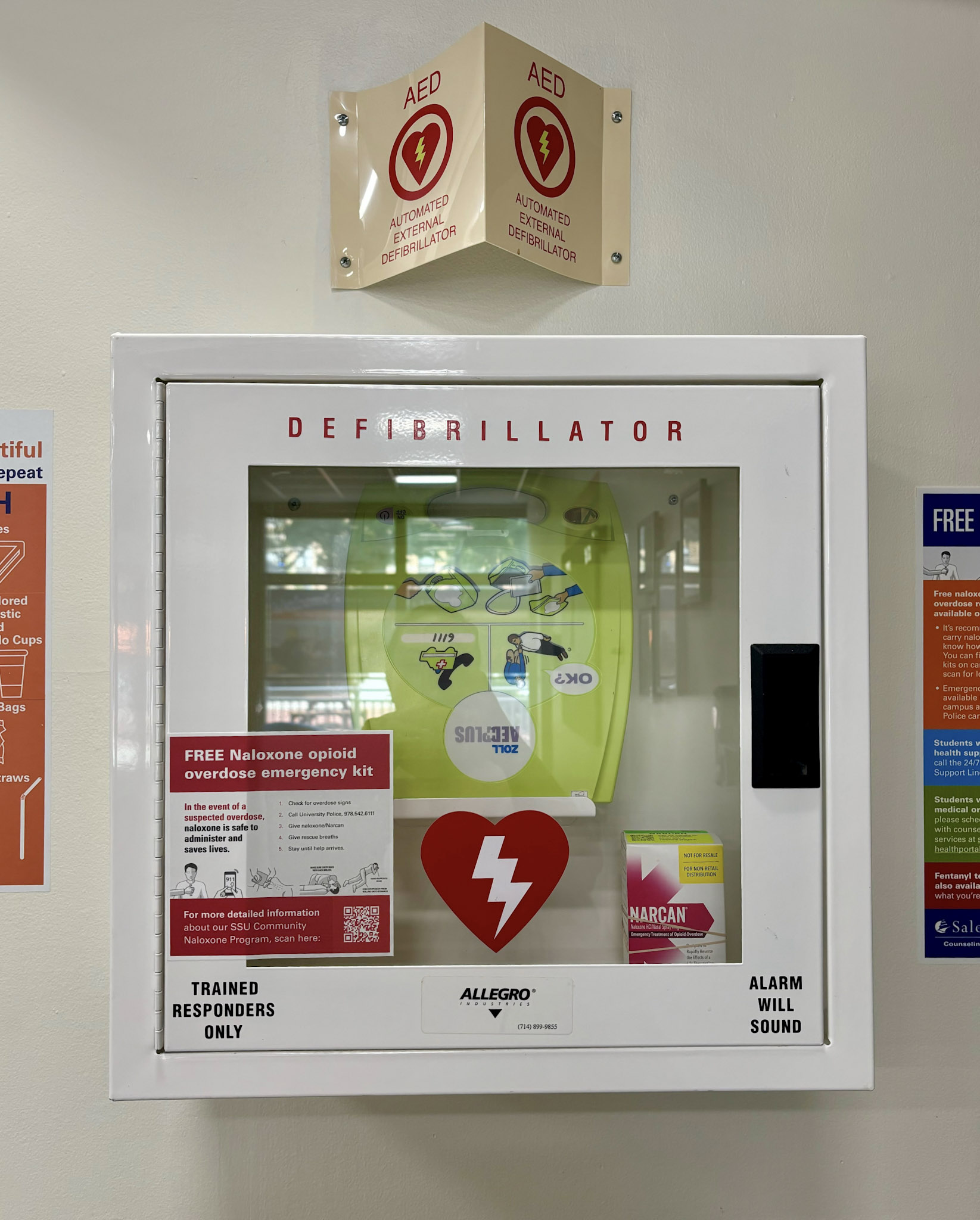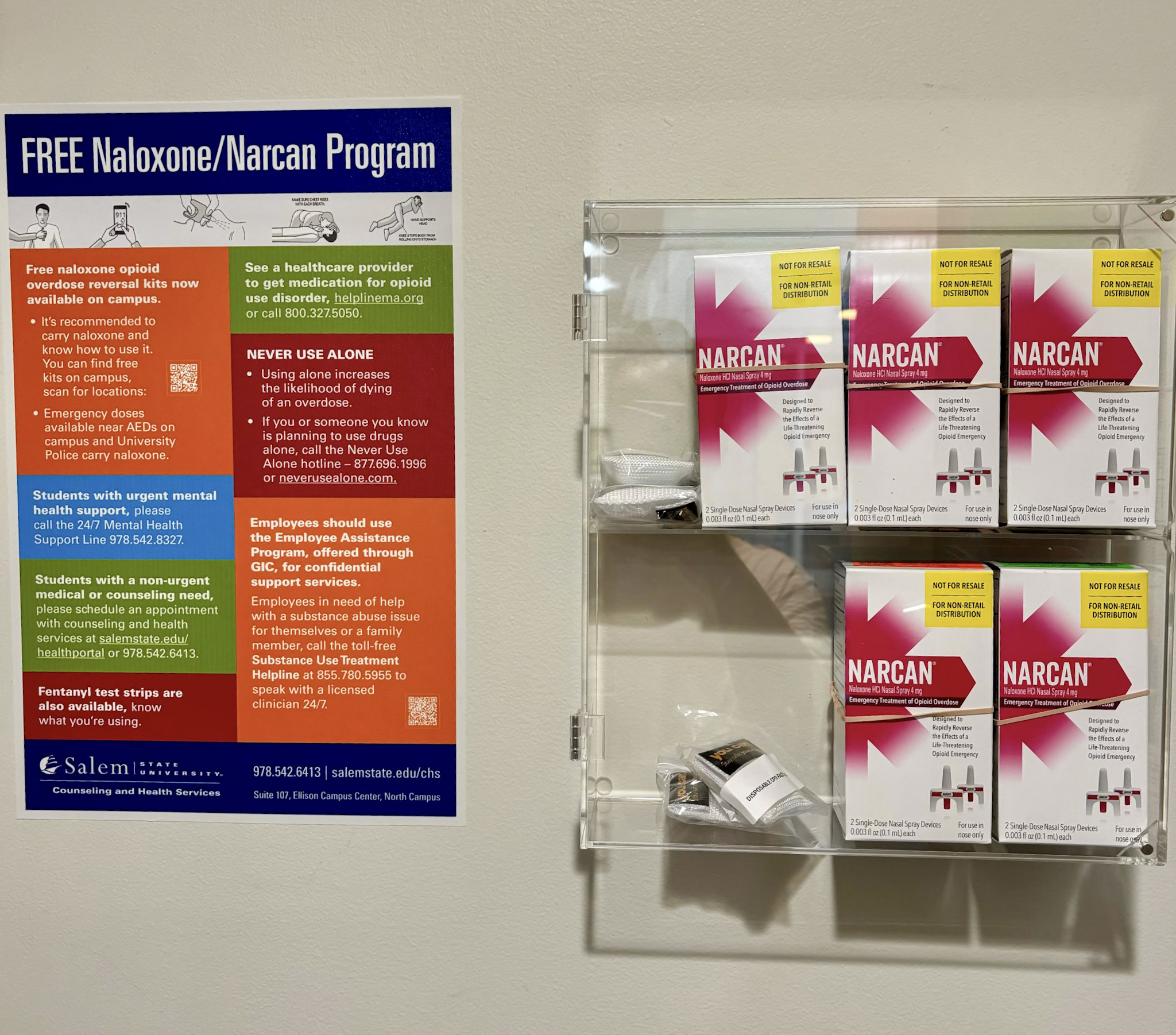Alert
An overdose is a medical emergency. Be prepared. Call 911 (off campus) or 978.542.6111 (on campus) immediately if you suspect an overdose. Carry Naloxone and administer it if you suspect an overdose. Save a life.

Understanding how to prevent an overdose and use Narcan (generic: naloxone), an anti-overdose medication, is now more important than ever. The risk of opioid overdose has increased in recent years, particularly as the potent opioid fentanyl has infiltrated the street drug supply, including stimulants like cocaine and pills (that may look like legit prescription pills but are made illegally). This website and campus resources are provided to help you learn how to stay safe and keep others safe from opioid overdose.
Students, staff, and faculty are encouraged to access the free naloxone, to keep and have on your person, should you witness an overdose.
Where to find Naloxone on Campus

Naloxone is available on campus in the following locations:
- Clear, unlocked and wall-mounted cases across campus:
- Berry Library, ground floor lobby near the elevator (closest to College Drive entrance)
- Ellison Campus Center, men and women’s bathrooms on the 1st floor
- O’Keefe Complex, 1st floor across from the elevator/staircase
- Gassett Fitness Center, between the locker rooms
- Student Navigation Center, hallway in front of the check-in desk
- Residence Life, Atlantic Hall, in front of the ATL residence life office
- Human Resources, on the wall in the front waiting area
- Dean of Students Office, Meier Hall245
- First Year Experience Office, outside the entrance
- In or by each AED case for emergency use
- In counseling and health services, at the front desk
- In the wellness vending machines
Each box of naloxone distributed on campus, has two things on it:
- An educational booklet on how to use the naloxone nasal spray.
- A QR code to a survey to anonymously report any reversed overdoses using naloxone from campus supply
Naloxone FAQs
- If you or a loved one struggles with opioid use, you should have naloxone nearby to reverse any overdoses.
- Ask family and friends to carry it and let them know where your naloxone is kept, in case they need to use it.
- People who have previously used opioids and have stopped are at a higher risk of an overdose. This includes people who have completed a detox program, have recently been released from jail, a residential treatment center or hospital. These people now have a lower tolerance for opioids and can overdose more easily.
- More street drugs are laced with a potent opioid, fentanyl. Even if you or a loved one isn’t using an opioid drug, other street drugs could cause an overdose.
Anyone.
- Naloxone is very safe and saves lives. It can be given to anyone showing signs of an opioid overdose, even if you are not sure if they have used opioids. Naloxone is not addictive and cannot be used to get high.
- Naloxone has been proven to be extremely safe, with no negative effects on the body if the person has not used opioids.
- Naloxone can be used on pregnant women in overdose situations.
- Naloxone dose not cause any life-threatening side effects.
**People with physical dependence on opioids may have signs of withdrawal within minutes after they are given naloxone, but this is normal and good because it means that the naloxone is helping the person to breathe again. Normal withdrawal symptoms can include headaches, changes in blood pressure, anxiety, rapid heart rate, sweating, nausea, vomiting, and tremors. These symptoms are not life threatening but can be uncomfortable.**
- Naloxone nasal sprays begin working within minutes after they are given and should help the person wake up and breathe again.
- If a person does not respond to the first dose of naloxone within 2-3 minutes, a second dose should be given. If using a nasal spray, a second dose requires a second spray bottle.
- Naloxone works for 30-90 minutes but because many opioids remain in the body longer than that, it is possible for a person to show signs of an overdose after naloxone wears off. Therefor, one of the most important steps is to call 911 so the person can receive medical attention to monitor their breathing and treat these possible effects. You should wait for emergency personnel to arrive and tell them about the products and doses you gave the patient.
- Get a prescription from your healthcare provider and bring to a pharmacy.
- Naloxone is available for purchase at most pharmacies
- Utilize the on-campus free community Narcan program
- Non-responsive to voice and sternal chest rub (rubbing knuckles over collarbones).
- Slow, weak, or not breathing; or slow, shallow breaths. May make deep snoring or gurgling sound.
- Falling asleep or losing consciousness
- Choking or gurgling sounds
- Limp body
- Cold and/or clammy skin
- Small, constricted “pinpoint pupils”
- Discolored skin (especially in lips and nails)
- Peel open package. Refer to administration guide on and in the box of medication.
- Spray naloxone into person’s nostril: hold spray device with thumb on bottom of red plunger and two fingers around nozzle- don’t spray until the nozzle is in the person’s nostrils. Press red plunger firmly to release dose of naloxone into person’s nose.
- Wait two minutes for it to take effect. Person will start breathing and come to. If not, spray another dose in the other nostril, if you have a second dose of naloxone.
- Administer CPR while waiting for paramedics to arrive if the person is still not responsive or breathing.
- How to administer nasal Narcan (naloxone) spray
- How to use naloxone (various nasal sprays or injectables)
- Never use alone
Note: Giving multiple doses of naloxone is sometimes necessary. If fentanyl is involved, because of its strength, overdoses can occur quickly and may require multiple doses of naloxone.
Additional Resources
Harm Reduction
- Using alone increases the likelihood of dying of an overdose. If you or someone you know is planning to use drugs alone, call the Never Use Alone hotline – 877.696.1996, where nonjudgemental peers will stay on the phone with you and call for help if necessary.
- Know what’s in your drugs and how to use fentanyl test strips
- Carry Naloxone and ask family/friends to carry or know where yours is kept
- See a healthcare provider to get medication for opioid use disorder, https://helplinema.org/ or call 800.327.5050
- If you have a healthcare provider, ask about treatment with methadone, buprenorphine, and naltrexone.
- Dispose of opioid medications properly
- Additional resources and education
Resources
- The Massachusetts Substance Use Helpline
- Stop an Overdose with Naloxone
- Massachusetts Behavioral Health Access (MABHA)
- Massachusetts syringe service programs
- RIZE Massachusetts
- Find Help- a social care network to provide healthier communities
- CDC Lifesaving Naloxone
- Family supports and grief and trauma resources
Additional Trainings
- Keep an eye on the Salem State University events and news calendar for on campus training opportunities
- Email prevention@salemstate.edu if you have a request for a specific training
- Off campus training opportunities can be found here
Mental Health Support
If a student needs urgent mental health support, please encourage use of the 24/7 Mental Health Support Line 978.542.8327.
For a non-urgent medical or counseling need, please schedule an appointment with counseling and health services at www.salemstate.edu/healthportal or 978.542.6413
Contact Us
Message us using the health portal.
Counseling and Health Services
352 Lafayette St.
Salem, MA 01970
